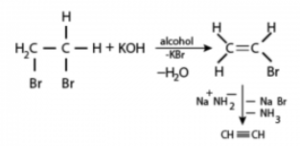In organic chemistry, alkynes are unsaturated hydrocarbons in which there is at least one triple bond between the carbon atoms of the two adjacent carbon atoms. It is possible that the synthesis of Alkynes will be beneficial due to its antibacterial, antifungal, and antiparasitic characteristics. The most important reaction in the synthesis of alkynes is the removal of ions from molecules, which results in the formation of pi bonds between the atoms. In most cases, one of two processes is involved in the production of alkynes: either the formation of a triple bond between carbon atoms or an increase in the number of molecules containing a triple bond should be carried out.
Making Alkynes Dehydrohalogenation of alkyl halides is a method of making alkynes.
Alkenes are created to react with a halogen by the use of this method of preparation. As a result of this reaction, a substituted alkane is produced.. The alkanes that are generated are subjected to further treatment with alcoholic KOH in order to form substituted alkenes. It is subsequently subjected to a reaction with sodium amide, resulting in the formation of alkynes. In order to obtain an alkyne, this procedure is referred to as dehydrohalogenation because hydrogen is removed along with a halogen during the process.
Dehydrohalogenation of alkyl halides is used in the preparation of alkynes.
Preparation of acetylene from calcium carbide.
Calcium carbide (CaC2) is produced to react with water in order to produce an alkyne on a big scale for industrial use. It is made by boiling quicklime in the presence of coke until it becomes liquid. Quicklime is produced by heating limestone to a high temperature. The reactions involved in the production of acetylene from calcium carbide are depicted in the reaction below:
CaCO3 → CaO + CO2
The reaction CaO + 3C → CaC2 + CO.
When you combine calcium carbonate and water, you get calcium oxalate and water.
Preparation using vicinal dihalides as starting materials
Dihalides are formed by reacting matching alkenes with halogens to produce dihalides (Group 17 elements). It is possible to generate alkynes from vicinal dihalides using a process known as dehydrohalogenation, which is performed in two steps:
The unsaturated halides must first be prepared, which is the first stage. The halides that are created have a halogen attached to a carbon that has been double-bonded. Vinylic halides are the name given to these halides, which are not reactive in nature. These halides are induced to react with the strong base, resulting in the synthesis of alkynes as a result of the reaction. In order to transform small alkynes into large alkynes, metal acetylides are utilised.

Conclusion
Therefore we can finally conclude that the most important reaction in the synthesis of alkynes is the removal of ions from molecules, which results in the formation of pi bonds between the atoms. In most cases, one of two processes is involved in the production of alkynes: either the formation of a triple bond between carbon atoms or an increase in the number of molecules containing a triple bond should be carried out.
 Profile
Profile Settings
Settings Refer your friends
Refer your friends Sign out
Sign out




